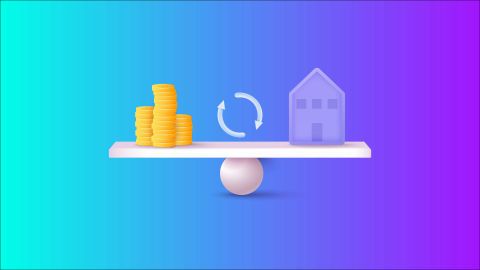Earning a salary of Rs. 7 lakh comes with its own set of financial considerations, particularly in the context of income tax.. Understanding the intricacies of the tax structure is crucial for effective financial planning. Read on to understand the key aspects of income tax on a Rs. 7 lakh salary, including insights on how to minimise tax liabilities under both the old and new tax regimes.
How to pay zero tax on a salary of Rs. 7 lakh
While it might seem challenging to aim for a zero-tax scenario on a Rs. 7 lakh salary, there are legitimate ways to optimise your tax planning. Leveraging available deductions, exemptions, and understanding the tax slabs can help you minimise your tax outflow. Here are some strategies to consider:
- Utilise deductions:
Take advantage of deductions under Section 80C, which includes investments in schemes like Provident Fund, Public Provident Fund (PPF), National Savings Certificate (NSC), and Equity-Linked Savings Scheme (ELSS). - Claim HRA benefits:
If you are a salaried individual and receive House Rent Allowance (HRA), ensure that you claim the benefits by providing the necessary rental receipts to get HRA rebate in income tax. - Utilise other deductions:
Explore other deductions available under sections like 80D (health insurance premiums), 80E (education loan interest), and 80G (donations to eligible charitable institutions).
Calculate income taxes based on different salary amount
Here’s a quick look at income tax liabilities for various salary brackets under the new regime:
Salary Amount |
Income Tax Amount (Approximate) |
Rs. 12,500 |
|
Rs. 10 lakh |
Rs. 1,00,000 |
Rs. 1,50,000 |
|
Rs. 1,80,000 |
Understanding your tax liability can help you plan better for your finances. For a comprehensive breakdown of income tax rates and deductions, consider using a tax calculator to simplify the process.
Old tax regime
This regime comprises a series of tax slabs for new and old income tax regime with varying rates based on different income brackets. It includes various deductions and exemptions that taxpayers can claim to reduce their taxable income. It is important to note that tax laws and structures are subject to change, and there might have been updates or amendments since my last knowledge update.
Here is a general overview of the old tax regime as applicable to individual taxpayers below 60 years of age:
Income tax slabs (FY 2021-22):
- Up to Rs. 2,50,000: Nil (no tax)
- Rs. 2,50,001 to Rs. 5,00,000: 5%
- Rs. 5,00,001 to Rs. 10,00,000: 20%
- Above Rs. 10,00,000: 30%
In addition to the income tax slabs, various deductions under sections such as 80C (for investments like Provident Fund and Life Insurance), 80D (for health insurance premiums), and other exemptions are available to reduce taxable income. The old tax regime offers taxpayers the flexibility to choose from a range of deductions based on their financial situation and goals.
New tax regime (from FY 23-24)
The new tax regime introduced a simplified structure with reduced tax rates. For individual taxpayers below 60 years of age, the tax slabs under the new regime were as follows:
Income Range |
Tax Rate |
Additional Information |
Up to Rs. 2,50,000 |
Nil |
No tax is applicable for incomes within this range. |
Rs. 2,50,001 to Rs. 5,00,000 |
5% |
Tax rate is 5% for incomes falling within this bracket. |
Rs. 5,00,001 to Rs. 7,50,000 |
10% |
Tax rate is 10% for incomes within this range. |
Rs. 7,50,001 to Rs. 10,00,000 |
15% |
Tax rate is 15% for incomes within this bracket. |
Rs. 10,00,001 to Rs. 12,50,000 |
20% |
Tax rate is 20% for incomes within this range. |
Rs. 12,50,001 to Rs. 15,00,000 |
25% |
Tax rate is 25% for incomes within this bracket. |
Above Rs. 15,00,000 |
30% |
Tax rate is 30% for incomes exceeding Rs. 15,00,000. |
How to calculate income tax on Rs. 7 lakh salary
- Determine gross income: Start with your total salary, which is Rs. 7 lakh.
- Apply deductions: Claim deductions under Section 80C, up to Rs. 1.5 lakh, if applicable.
- Calculate taxable income: Subtract deductions from your gross income (Rs. 7 lakh - Rs. 1.5 lakh = Rs. 5.5 lakh).
- Refer to tax slabs: Based on your taxable income, calculate the tax using applicable slabs.
- Use an income tax calculator for accurate results.
Under the new tax regime, several deductions and exemptions available in the old regime were not applicable. Taxpayers had the flexibility to choose between the old and new regimes based on their specific financial situations and preferences.
In conclusion, managing income tax on a Rs. 7 lakh salary involves a strategic approach to maximise deductions and choose the tax regime that aligns with your financial goals. Whether opting for the old tax regime with its varied deductions or the new simplified tax structure, understanding the nuances empowers you to make informed decisions for effective tax planning.




